2008 BMW 335XI tire pressure reset
[x] Cancel search: tire pressure resetPage 91 of 274
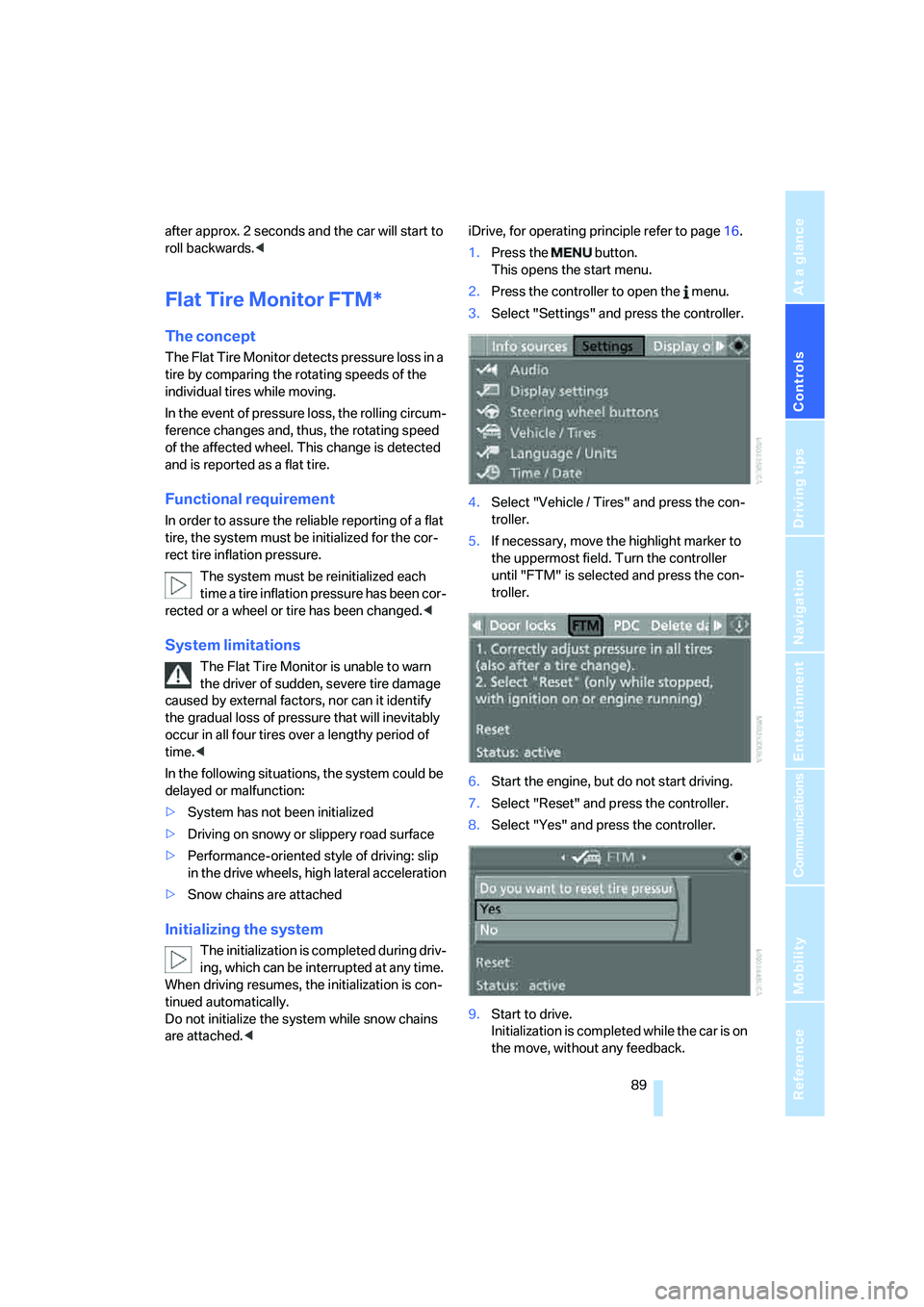
Controls
89Reference
At a glance
Driving tips
Communications
Navigation
Entertainment
Mobility
after approx. 2 seconds and the car will start to
roll backwards.<
Flat Tire Monitor FTM*
The concept
The Flat Tire Monitor detects pressure loss in a
tire by comparing the rotating speeds of the
individual tires while moving.
In the event of pressure loss, the rolling circum-
ference changes and, thus, the rotating speed
of the affected wheel. This change is detected
and is reported as a flat tire.
Functional requirement
In order to assure the reliable reporting of a flat
tire, the system must be initialized for the cor-
rect tire inflation pressure.
The system must be reinitialized each
time a tire inflation pressure has been cor-
rected or a wheel or tire has been changed.<
System limitations
The Flat Tire Monitor is unable to warn
the driver of sudden, severe tire damage
caused by external factors, nor can it identify
the gradual loss of pressure that will inevitably
occur in all four tires over a lengthy period of
time.<
In the following situations, the system could be
delayed or malfunction:
>System has not been initialized
>Driving on snowy or slippery road surface
>Performance-oriented style of driving: slip
in the drive wheels, high lateral acceleration
>Snow chains are attached
Initializing the system
The initialization is completed during driv-
ing, which can be interrupted at any time.
When driving resumes, the initialization is con-
tinued automatically.
Do not initialize the system while snow chains
are attached.
This opens the start menu.
2.Press the controller to open the menu.
3.Select "Settings" and press the controller.
4.Select "Vehicle / Tires" and press the con-
troller.
5.If necessary, move the highlight marker to
the uppermost field. Turn the controller
until "FTM" is selected and press the con-
troller.
6.Start the engine, but do not start driving.
7.Select "Reset" and press the controller.
8.Select "Yes" and press the controller.
9.Start to drive.
Initialization is completed while the car is on
the move, without any feedback.
Page 92 of 274
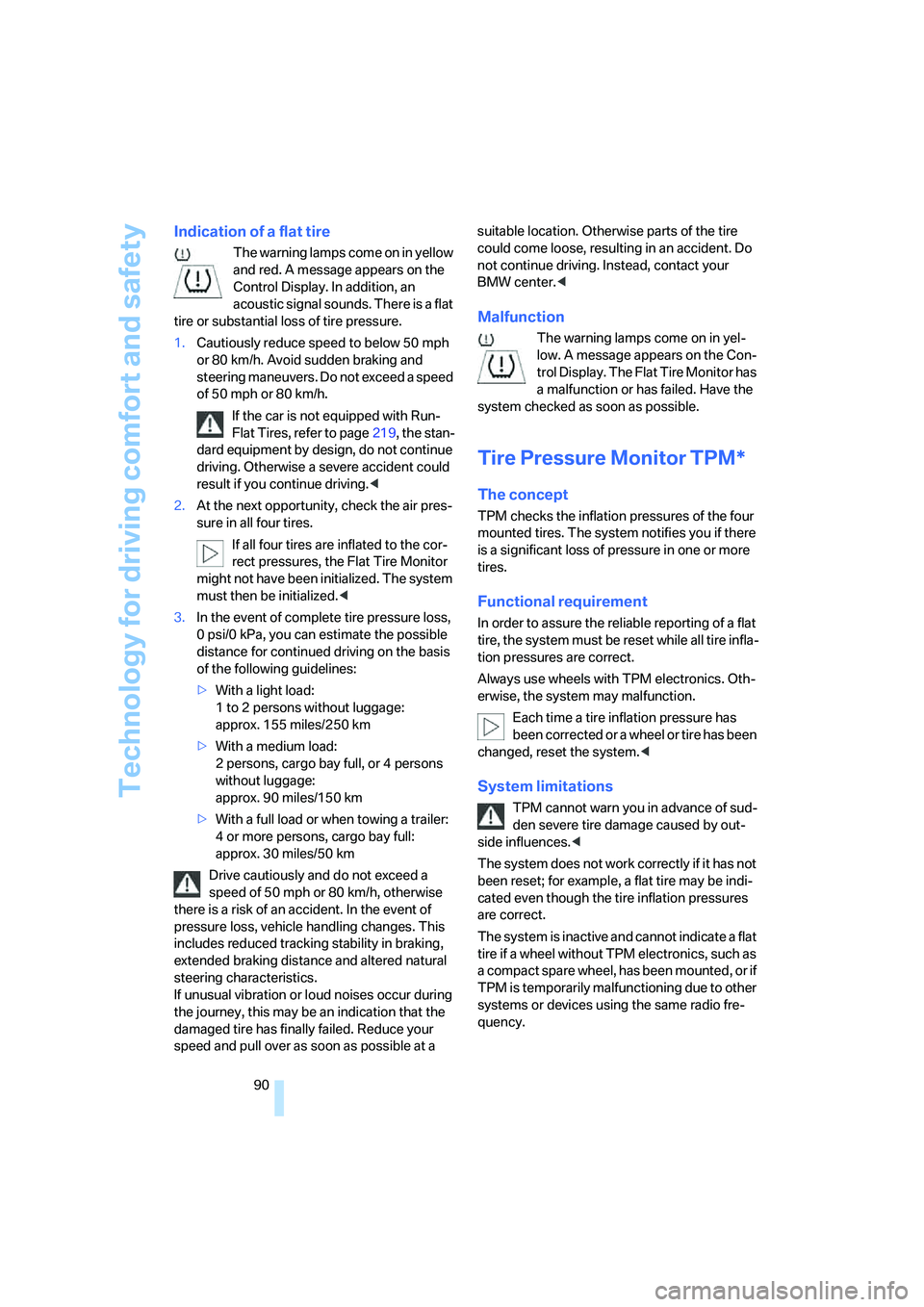
Technology for driving comfort and safety
90
Indication of a flat tire
The warning lamps come on in yellow
and red. A message appears on the
Control Display. In addition, an
acoustic signal sounds. There is a flat
tire or substantial loss of tire pressure.
1.Cautiously reduce speed to below 50 mph
or 80 km/h. Avoid sudden braking and
steering maneuvers. Do not exceed a speed
of 50 mph or 80 km/h.
If the car is not equipped with Run-
Flat Tires, refer to page219, the stan-
dard equipment by design, do not continue
driving. Otherwise a severe accident could
result if you continue driving.<
2.At the next opportunity, check the air pres-
sure in all four tires.
If all four tires are inflated to the cor-
rect pressures, the Flat Tire Monitor
might not have been initialized. The system
must then be initialized.<
3.In the event of complete tire pressure loss,
0 psi/0 kPa, you can estimate the possible
distance for continued driving on the basis
of the following guidelines:
>With a light load:
1 to 2 persons without luggage:
approx. 155 miles/250 km
>With a medium load:
2 persons, cargo bay full, or 4 persons
without luggage:
approx. 90 miles/150 km
>With a full load or when towing a trailer:
4 or more persons, cargo bay full:
approx. 30 miles/50 km
Drive cautiously and do not exceed a
speed of 50 mph or 80 km/h, otherwise
there is a risk of an accident. In the event of
pressure loss, vehicle handling changes. This
includes reduced tracking stability in braking,
extended braking distance and altered natural
steering characteristics.
If unusual vibration or loud noises occur during
the journey, this may be an indication that the
damaged tire has finally failed. Reduce your
speed and pull over as soon as possible at a suitable location. Otherwise parts of the tire
could come loose, resulting in an accident. Do
not continue driving. Instead, contact your
BMW center.<
Malfunction
The warning lamps come on in yel-
low. A message appears on the Con-
trol Display. The Flat Tire Monitor has
a malfunction or has failed. Have the
system checked as soon as possible.
Tire Pressure Monitor TPM*
The concept
TPM checks the inflation pressures of the four
mounted tires. The system notifies you if there
is a significant loss of pressure in one or more
tires.
Functional requirement
In order to assure the reliable reporting of a flat
tire, the system must be reset while all tire infla-
tion pressures are correct.
Always use wheels with TPM electronics. Oth-
erwise, the system may malfunction.
Each time a tire inflation pressure has
been corrected or a wheel or tire has been
changed, reset the system.<
System limitations
TPM cannot warn you in advance of sud-
den severe tire damage caused by out-
side influences.<
The system does not work correctly if it has not
been reset; for example, a flat tire may be indi-
cated even though the tire inflation pressures
are correct.
The system is inactive and cannot indicate a flat
tire if a wheel without TPM electronics, such as
a compact spare wheel, has been mounted, or if
TPM is temporarily malfunctioning due to other
systems or devices using the same radio fre-
quency.
Page 93 of 274
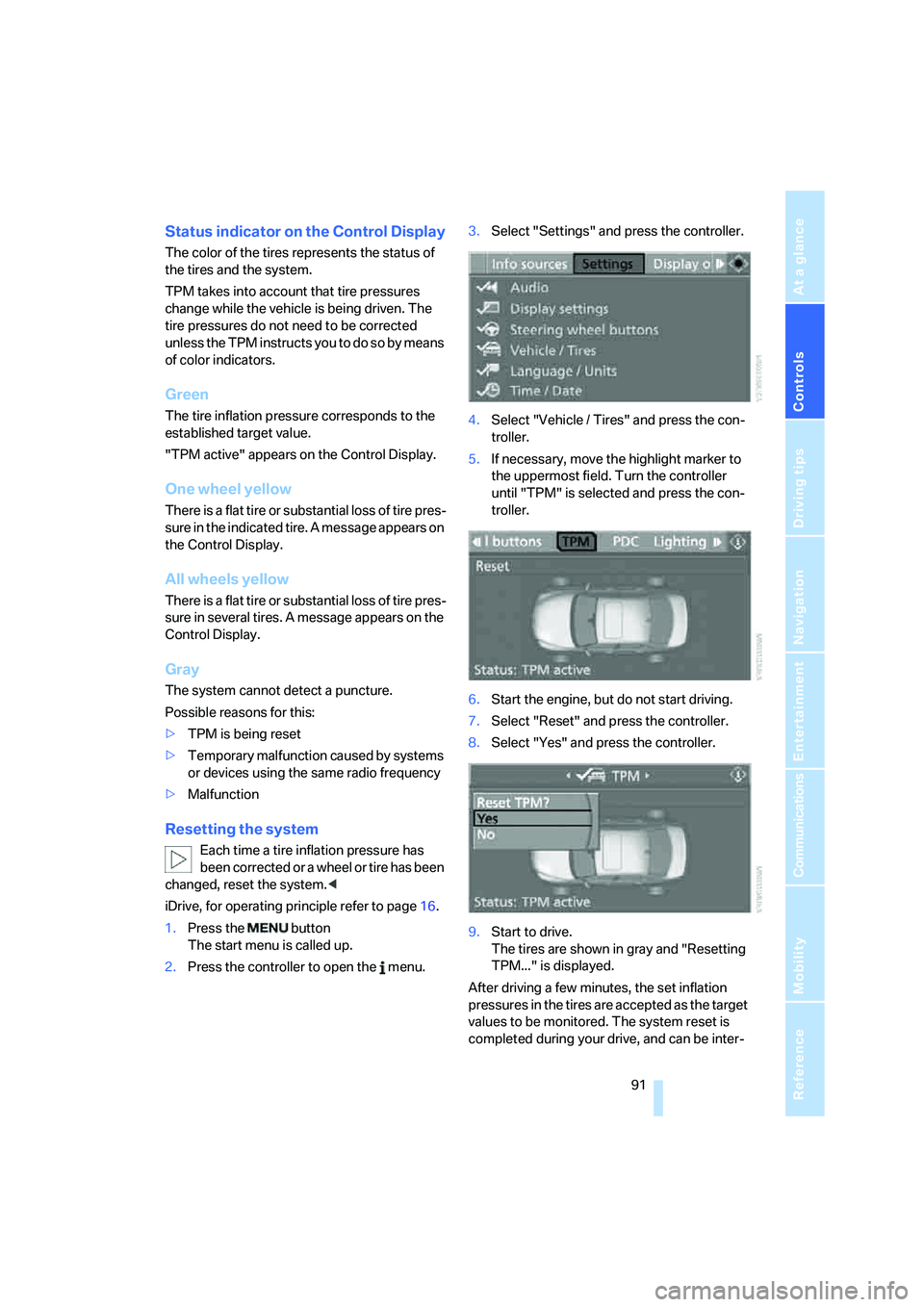
Controls
91Reference
At a glance
Driving tips
Communications
Navigation
Entertainment
Mobility
Status indicator on the Control Display
The color of the tires represents the status of
the tires and the system.
TPM takes into account that tire pressures
change while the vehicle is being driven. The
tire pressures do not need to be corrected
unless the TPM instructs you to do so by means
of color indicators.
Green
The tire inflation pressure corresponds to the
established target value.
"TPM active" appears on the Control Display.
One wheel yellow
There is a flat tire or substantial loss of tire pres-
sure in the indicated tire. A message appears on
the Control Display.
All wheels yellow
There is a flat tire or substantial loss of tire pres-
sure in several tires. A message appears on the
Control Display.
Gray
The system cannot detect a puncture.
Possible reasons for this:
>TPM is being reset
>Temporary malfunction caused by systems
or devices using the same radio frequency
>Malfunction
Resetting the system
Each time a tire inflation pressure has
been corrected or a wheel or tire has been
changed, reset the system.<
iDrive, for operating principle refer to page16.
1.Press the button
The start menu is called up.
2.Press the controller to open the menu.3.Select "Settings" and press the controller.
4.Select "Vehicle / Tires" and press the con-
troller.
5.If necessary, move the highlight marker to
the uppermost field. Turn the controller
until "TPM" is selected and press the con-
troller.
6.Start the engine, but do not start driving.
7.Select "Reset" and press the controller.
8.Select "Yes" and press the controller.
9.Start to drive.
The tires are shown in gray and "Resetting
TPM..." is displayed.
After driving a few minutes, the set inflation
pressures in the tires are accepted as the target
values to be monitored. The system reset is
completed during your drive, and can be inter-
will be adapted
will be adapted
Page 94 of 274
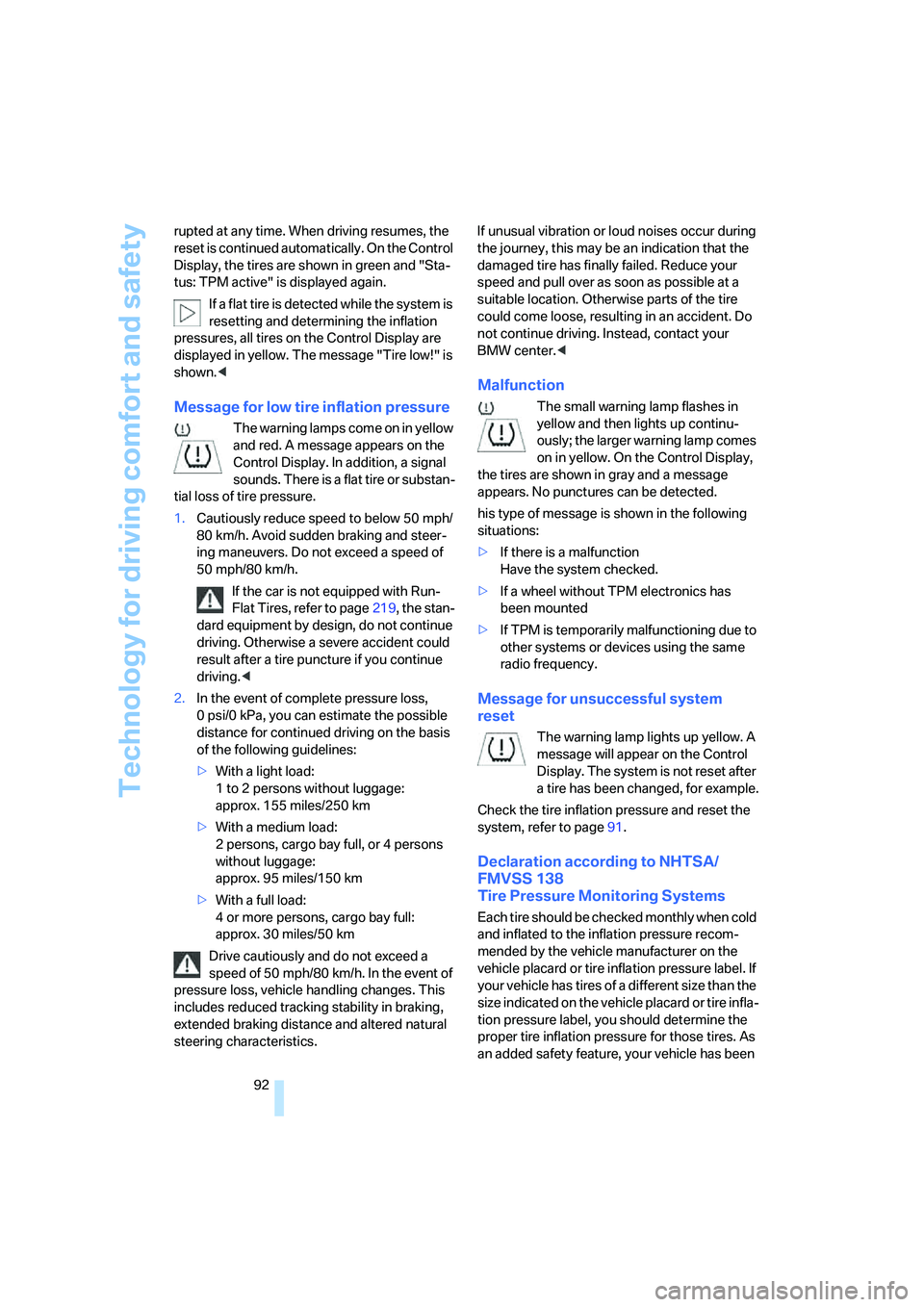
Technology for driving comfort and safety
92 rupted at any time. When driving resumes, the
reset is continued automatically. On the Control
Display, the tires are shown in green and "Sta-
tus: TPM active" is displayed again.
If a flat tire is detected while the system is
resetting and determining the inflation
pressures, all tires on the Control Display are
displayed in yellow. The message "Tire low!" is
shown.<
Message for low tire inflation pressure
The warning lamps come on in yellow
and red. A message appears on the
Control Display. In addition, a signal
sounds. There is a flat tire or substan-
tial loss of tire pressure.
1.Cautiously reduce speed to below 50 mph/
80 km/h. Avoid sudden braking and steer-
ing maneuvers. Do not exceed a speed of
50 mph/80 km/h.
If the car is not equipped with Run-
Flat Tires, refer to page219, the stan-
dard equipment by design, do not continue
driving. Otherwise a severe accident could
result after a tire puncture if you continue
driving.<
2.In the event of complete pressure loss,
0 psi/0 kPa, you can estimate the possible
distance for continued driving on the basis
of the following guidelines:
>With a light load:
1 to 2 persons without luggage:
approx. 155 miles/250 km
>With a medium load:
2 persons, cargo bay full, or 4 persons
without luggage:
approx. 95 miles/150 km
>With a full load:
4 or more persons, cargo bay full:
approx. 30 miles/50 km
Drive cautiously and do not exceed a
speed of 50 mph/80 km/h. In the event of
pressure loss, vehicle handling changes. This
includes reduced tracking stability in braking,
extended braking distance and altered natural
steering characteristics.If unusual vibration or loud noises occur during
the journey, this may be an indication that the
damaged tire has finally failed. Reduce your
speed and pull over as soon as possible at a
suitable location. Otherwise parts of the tire
could come loose, resulting in an accident. Do
not continue driving. Instead, contact your
BMW center.<
Malfunction
The small warning lamp flashes in
yellow and then lights up continu-
ously; the larger warning lamp comes
on in yellow. On the Control Display,
the tires are shown in gray and a message
appears. No punctures can be detected.
his type of message is shown in the following
situations:
>If there is a malfunction
Have the system checked.
>If a wheel without TPM electronics has
been mounted
>If TPM is temporarily malfunctioning due to
other systems or devices using the same
radio frequency.
Message for unsuccessful system
reset
The warning lamp lights up yellow. A
message will appear on the Control
Display. The system is not reset after
a tire has been changed, for example.
Check the tire inflation pressure and reset the
system, refer to page91.
Declaration according to NHTSA/
FMVSS 138
Tire Pressure Monitoring Systems
Each tire should be checked monthly when cold
and inflated to the inflation pressure recom-
mended by the vehicle manufacturer on the
vehicle placard or tire inflation pressure label. If
your vehicle has tires of a different size than the
size indicated on the vehicle placard or tire infla-
tion pressure label, you should determine the
proper tire inflation pressure for those tires. As
an added safety feature, your vehicle has been
Page 265 of 274
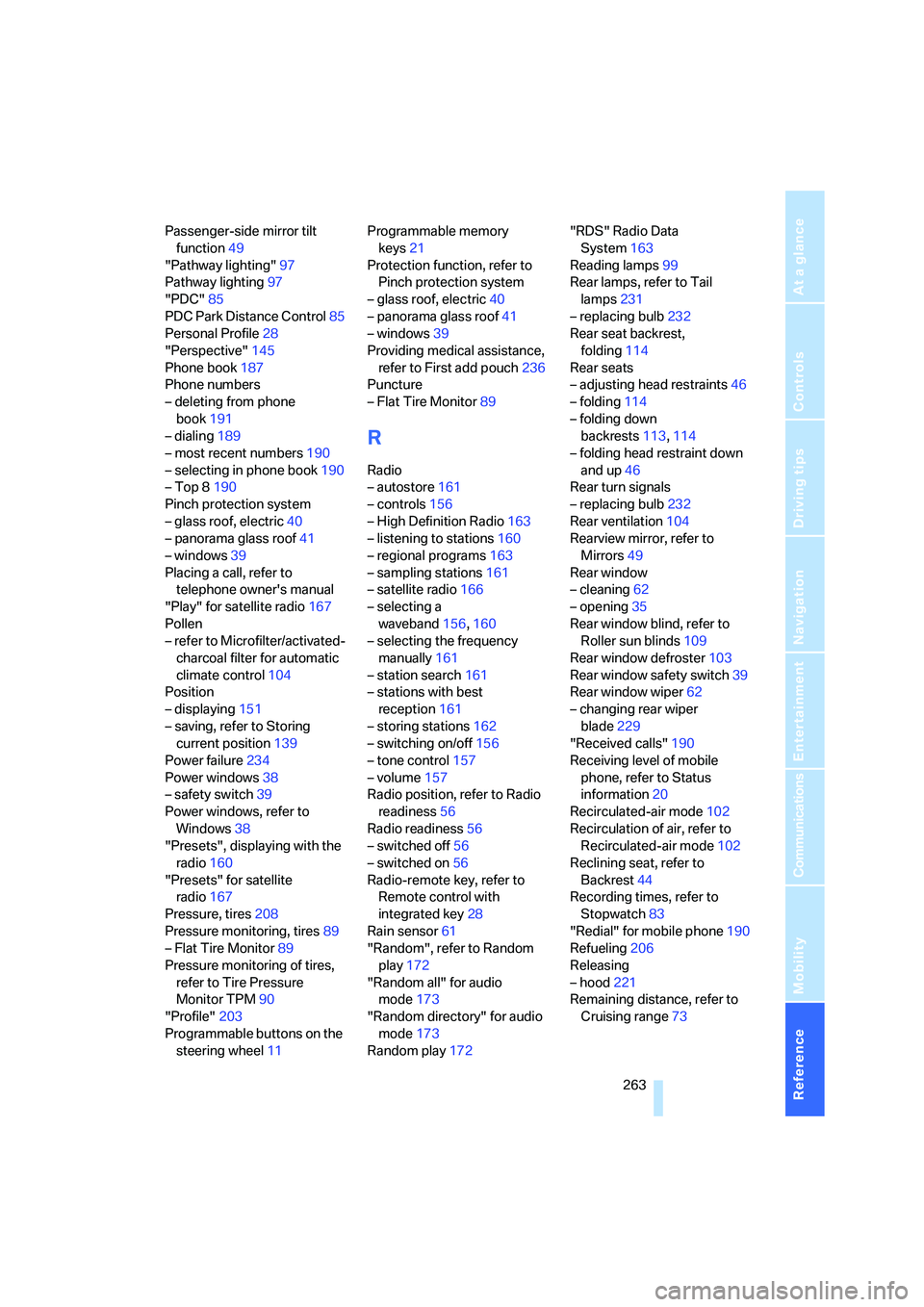
Reference 263
At a glance
Controls
Driving tips
Communications
Navigation
Entertainment
Mobility
Passenger-side mirror tilt
function49
"Pathway lighting"97
Pathway lighting97
"PDC"85
PDC Park Distance Control85
Personal Profile28
"Perspective"145
Phone book187
Phone numbers
– deleting from phone
book191
– dialing189
– most recent numbers190
– selecting in phone book190
– Top 8190
Pinch protection system
– glass roof, electric40
– panorama glass roof41
– windows39
Placing a call, refer to
telephone owner's manual
"Play" for satellite radio167
Pollen
– refer to Microfilter/activated-
charcoal filter for automatic
climate control104
Position
– displaying151
– saving, refer to Storing
current position139
Power failure234
Power windows38
– safety switch39
Power windows, refer to
Windows38
"Presets", displaying with the
radio160
"Presets" for satellite
radio167
Pressure, tires208
Pressure monitoring, tires89
– Flat Tire Monitor89
Pressure monitoring of tires,
refer to Tire Pressure
Monitor TPM90
"Profile"203
Programmable buttons on the
steering wheel11Programmable memory
keys21
Protection function, refer to
Pinch protection system
– glass roof, electric40
– panorama glass roof41
– windows39
Providing medical assistance,
refer to First add pouch236
Puncture
– Flat Tire Monitor89
R
Radio
– autostore161
– controls156
– High Definition Radio163
– listening to stations160
– regional programs163
– sampling stations161
– satellite radio166
– selecting a
waveband156,160
– selecting the frequency
manually161
– station search161
– stations with best
reception161
– storing stations162
– switching on/off156
– tone control157
– volume157
Radio position, refer to Radio
readiness56
Radio readiness56
– switched off56
– switched on56
Radio-remote key, refer to
Remote control with
integrated key28
Rain sensor61
"Random", refer to Random
play172
"Random all" for audio
mode173
"Random directory" for audio
mode173
Random play172"RDS" Radio Data
System163
Reading lamps99
Rear lamps, refer to Tail
lamps231
– replacing bulb232
Rear seat backrest,
folding114
Rear seats
– adjusting head restraints46
– folding114
– folding down
backrests113,114
– folding head restraint down
and up46
Rear turn signals
– replacing bulb232
Rear ventilation104
Rearview mirror, refer to
Mirrors49
Rear window
– cleaning62
– opening35
Rear window blind, refer to
Roller sun blinds109
Rear window defroster103
Rear window safety switch39
Rear window wiper62
– changing rear wiper
blade229
"Received calls"190
Receiving level of mobile
phone, refer to Status
information20
Recirculated-air mode102
Recirculation of air, refer to
Recirculated-air mode102
Reclining seat, refer to
Backrest44
Recording times, refer to
Stopwatch83
"Redial" for mobile phone190
Refueling206
Releasing
– hood221
Remaining distance, refer to
Cruising range73
Page 266 of 274
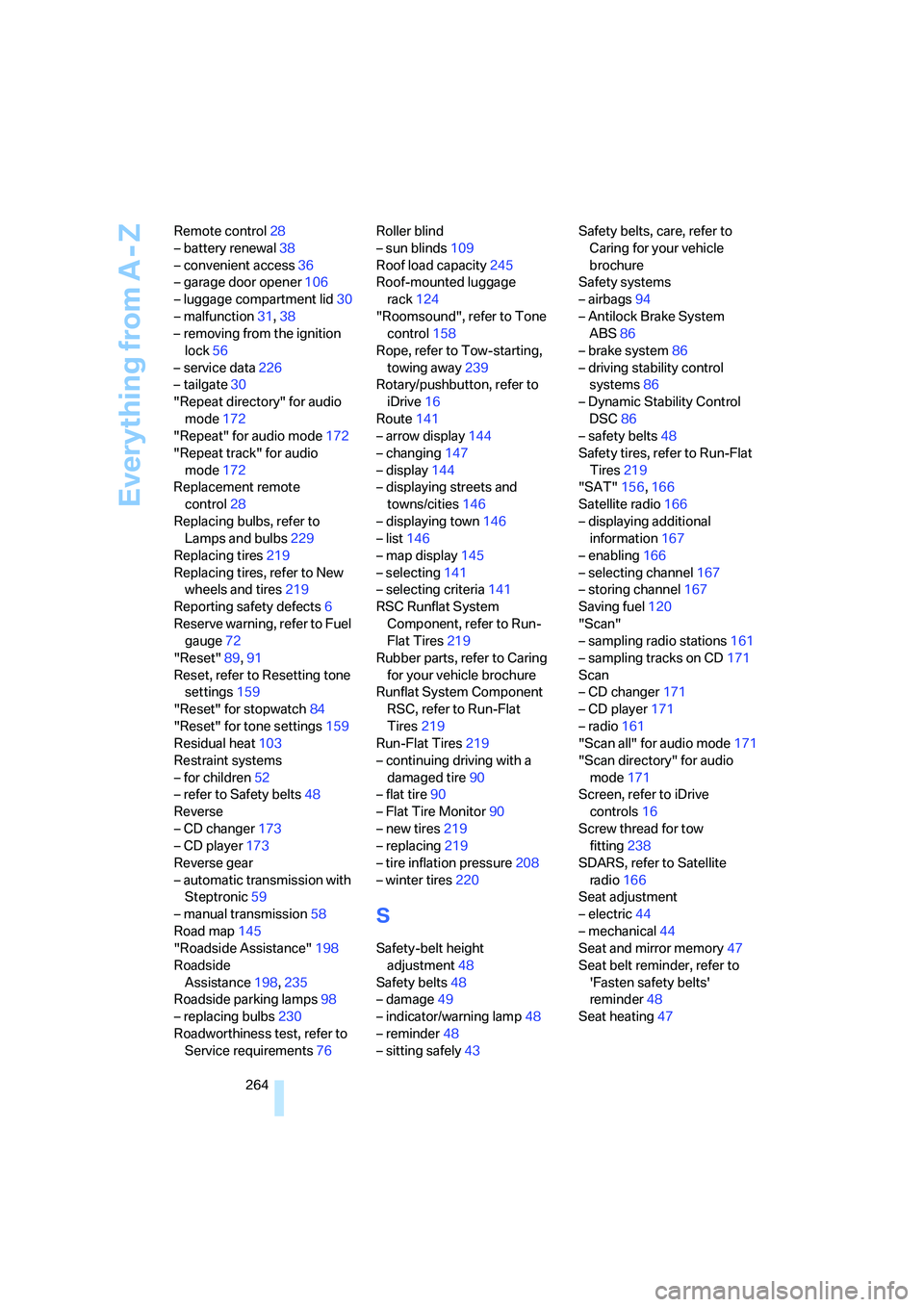
Everything from A - Z
264 Remote control28
– battery renewal38
– convenient access36
– garage door opener106
– luggage compartment lid30
– malfunction31,38
– removing from the ignition
lock56
– service data226
– tailgate30
"Repeat directory" for audio
mode172
"Repeat" for audio mode172
"Repeat track" for audio
mode172
Replacement remote
control28
Replacing bulbs, refer to
Lamps and bulbs229
Replacing tires219
Replacing tires, refer to New
wheels and tires219
Reporting safety defects6
Reserve warning, refer to Fuel
gauge72
"Reset"89,91
Reset, refer to Resetting tone
settings159
"Reset" for stopwatch84
"Reset" for tone settings159
Residual heat103
Restraint systems
– for children52
– refer to Safety belts48
Reverse
– CD changer173
– CD player173
Reverse gear
– automatic transmission with
Steptronic59
– manual transmission58
Road map145
"Roadside Assistance"198
Roadside
Assistance198,235
Roadside parking lamps98
– replacing bulbs230
Roadworthiness test, refer to
Service requirements76Roller blind
– sun blinds109
Roof load capacity245
Roof-mounted luggage
rack124
"Roomsound", refer to Tone
control158
Rope, refer to Tow-starting,
towing away
239
Rotary/pushbutton, refer to
iDrive16
Route141
– arrow display144
– changing147
– display144
– displaying streets and
towns/cities146
– displaying town146
– list146
– map display145
– selecting141
– selecting criteria141
RSC Runflat System
Component, refer to Run-
Flat Tires219
Rubber parts, refer to Caring
for your vehicle brochure
Runflat System Component
RSC, refer to Run-Flat
Tires219
Run-Flat Tires219
– continuing driving with a
damaged tire90
– flat tire90
– Flat Tire Monitor90
– new tires219
– replacing219
– tire inflation pressure208
– winter tires220
S
Safety-belt height
adjustment48
Safety belts48
– damage49
– indicator/warning lamp48
– reminder48
– sitting safely43Safety belts, care, refer to
Caring for your vehicle
brochure
Safety systems
– airbags94
– Antilock Brake System
ABS86
– brake system86
– driving stability control
systems86
– Dynamic Stability Control
DSC86
– safety belts48
Safety tires, refer to Run-Flat
Tires219
"SAT"156,166
Satellite radio166
– displaying additional
information167
– enabling166
– selecting channel167
– storing channel167
Saving fuel120
"Scan"
– sampling radio stations161
– sampling tracks on CD171
Scan
– CD changer171
– CD player171
– radio161
"Scan all" for audio mode171
"Scan directory" for audio
mode171
Screen, refer to iDrive
controls16
Screw thread for tow
fitting238
SDARS, refer to Satellite
radio166
Seat adjustment
– electric44
– mechanical44
Seat and mirror memory47
Seat belt reminder, refer to
'Fasten safety belts'
reminder48
Seat heating47
Page 269 of 274

Reference 267
At a glance
Controls
Driving tips
Communications
Navigation
Entertainment
Mobility
"Time / Date"79,80,81
"Time format"80
Timer, refer to Preselecting
switch-on times104
"Timer 2" for parked car
ventilation/heating105
"Timer 1" for parked car
ventilation/heating105
Tire inflation pressure208
– loss90,91
Tire pressure monitoring,
refer to Flat Tire Monitor89
Tire Pressure Monitor
TPM90
– resetting the system91
– system limitations90
– warning lamp92
Tire puncture, refer to Flat Tire
Monitor90
Tire Quality Grading217
Tires
– age217,218
– air loss92
– breaking in120
– changing, refer to Changing
wheels233
– condition218
– damage218
– inflation pressure208
– labels217
– minimum tread depth218
– new wheels and tires219
– pressure monitoring, refer to
Flat Tire Monitor89
– pressure monitoring, refer to
Tire Pressure Monitor
TPM90
– puncture90
– replacing219
– Run-Flat219
– size217
– storage220
– tread depth218
– wear indicators, refer to
Minimum tread depth218
– wheel/tire combination, refer
to Correct wheels and
tires219
– winter tires220TMC station, refer to Traffic
information147
"Tone"157
Tone in audio mode
– adjusting157
– middle setting159
Tools, refer to Onboard tool
kit228
"Top 8" for mobile phone190
Torque, refer to Engine
data242
Touch tone dialing192
Tow bar238
Tow fitting238
– screw thread238
Tow fittings for tow-starting
and towing away238
Towing237
– car with automatic
transmission237
– methods238
Towing and tow-starting237
Town/city for destination131
"Town / City" in destination
entry131
Tow rope239
Tow-starting237,239
"TPM"91
TPM, refer to Tire Pressure
Monitor90
Tracks
– random play sequence172
– sampling, Scan171
– searching for171
Track width, refer to
Dimensions243
Traction control, refer to DSC
Dynamic Stability
Control86
Traffic information for
navigation
– calling up148
– display on route map149
– during destination
guidance150
– switching on/off147
– symbols150
"Traffic Info settings"148Traffic jam
– displaying traffic
information147
– driving around150
Transmission
– automatic transmission with
Steptronic58
– manual transmission58
– overriding selector lever lock
for automatic transmission
with Steptronic60
Transmission interlock
– refer to Changing selector
lever position59
– refer to P Park59
Transporting children
safely52
Transport securing devices,
refer to Securing cargo124
Tread depth, refer to Minimum
tire tread
218
Treble, refer to Treble and
bass157
Treble, tone control157
"Trip computer"74
Trip computer74
Trip-distance counter, refer to
Trip odometer71
"Triple turn signal"61
Triple turn signal activation61
Trip odometer71
Trunk, refer to Cargo bay114
Trunk lid33
Trunk lid, refer to Luggage
compartment lid/tailgate33
Turning circle, refer to
Dimensions243
Turn signal indicators
– indicator/warning lamp12
– replacing bulbs231
– triple turn signal61
Turn signals60
Tying down loads, refer to
Cargo loading124